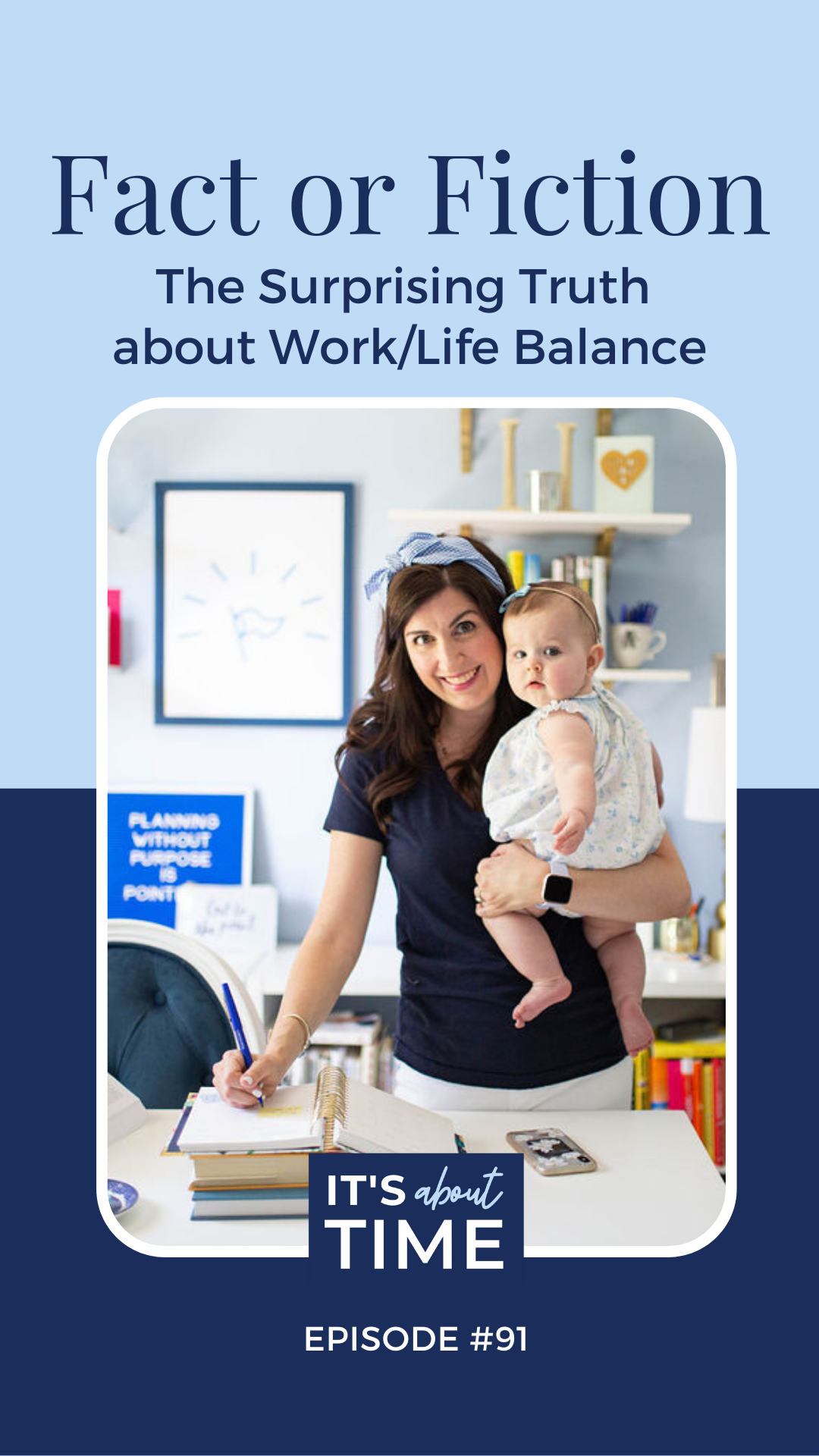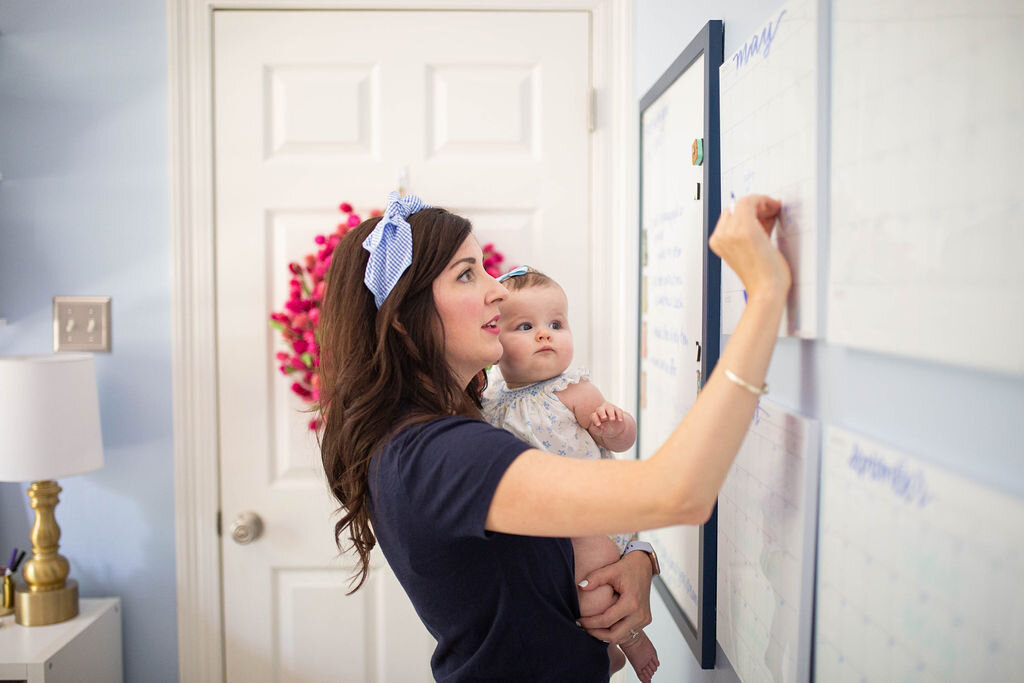LISTEN IN APPLE PODCASTS | LISTEN IN SPOTIFY | LISTEN IN STITCHER

Hey friends, and welcome to Episode 91 of It’s About Time – a Podcast sharing stories and strategies to inspire women seeking better Work, Life and Balance. I’m your host time management coach, Anna Dearmon Kornick and there are a lot of thoughts, feelings and beliefs around the topic of today’s episode: work/life balance. Is it even real? Should we be striving for it? What does it even mean?
I feel like every time I turn around, I’m seeing an article with tips for better work/life balance, or I’m hearing a speaker on stage saying that work/life balance isn’t a real thing. Well… which is it?
So today, I’m diving into
-
Why this is a conversation worth having
-
I’ll go all the way back to the origin of work/life balance
-
We’ll look at how different generations interpret work/life balance
-
And we’ll break it down piece by piece to get to the bottom of this
It’s early morning, late May, 1953. Two men, Sir Edmund Hillary from New Zealand and Tenzing Norgay, a Sherpa born in India, set out to do what no man had ever done before. And what many men had lost their lives attempting. Hillary and Norgay suited up and made their way to the top of the highest mountain in the world, Mount Everest.
Pushing their way through the icy, uncharted terrain, they arrived at the top of Everest’s 29,035 foot summit at 11:30 a.m. on May 29th and they made history.
At that point, many climbers before them had tried to reach the mountaintop – the first attempt being 32 years earlier in 1921. As you can imagine, a lot changed in those 32 years.
Most notably? Technology. Hillary and Norgay’s 11-man climbing team was outfitted with insulated boots and clothing, radio equipment and oxygen systems that made navigating the high altitudes and rocky terrain just a little more possible than in the past.
But despite the advances in technology, Hillary and Norgay had to forge a new passage. They had to take steps that no one had ever taken and traverse a path that no one else had ever cleared in order to make it to the top.
Since that historic day – May 29th – which, by the way, is my birthday, more than 4000 climbers have reached the top.
So what does this have to do with work life balance and whether work life balance is a thing?
Trust me. It does. But we’re gonna come back to that in a bit.
Work/life balance is hard
I think we can all agree that the quest for work/life balance can feel like climbing a mountain sometimes. It’s rocky, sometimes it’s hard to breathe. It’s a lot of work, and it feels like we have to carry a ton of baggage with us along the way. If we make a wrong move, the slightest misstep, everything could come crashing down.
But this episode isn’t meant to debate whether or not work life balance is hard… it’s to tackle the existence of work/life balance itself.
-
Is it real?
-
Is it something we should strive for?
-
It is a fool’s errand?
-
Is it a concept sold to us by self-help gurus so we’ll buy their latest book, their course, drink their fitness tea, buy tickets to their retreat or invest in whatever they’re selling?
And then lately it feels like I can’t open a magazine or listen to a motivational speaker without reading or hearing, “Work/life balance? It’s not real.”
Well – is it real, or is it not?
why does this matter?
Fact or Fiction: Work/Life Balance. Why does this matter, and why is it worth talking about?
From my perspective as a Time Management Coach and someone who is constantly digging into the topics of productivity, self-care, personal development and career success this is why:
Our beliefs about work/life balance shape our attitudes and our efforts toward how we manage our time and what we believe is possible.
I’m gonna say that one more time. Our beliefs about work/life balance shape our attitudes and our efforts toward how we manage our time and what we believe is possible.
So if we believe it’s real, that affects how we show up.
If we believe it’s not real, that also affects how we show up.
the origin of work/life balance
But first – We kicked off this episode at the top of Mt. Everest in the 50’s. Let’s fast forward a bit to the United Kingdom in the 80s. To the moment in history where the concept of work/life balance was born.
I believe that in order to understand, well, anything, it’s important to understand the origin story. Where did it all begin and why?
The UK Women’s Liberation Movement
The term work/life balance first appeared in the UK as a issue in the Women’s Liberation Movement. In a nutshell, this movement advocated a flexible working schedule and maternity leave for women. At the time, the dominating societal belief was that women were expected to have a career and continue to be the primary manager of the family and home.
The Invisible Load
You’ve probably heard this expectation called The Invisible Load, Emotional Labor, or the Mental Load. I should do an entire episode just on this topic, but it’s basically all the little and big things that typically fall on the woman in a male/female relationship when it comes to managing a household. The cooking. The cleaning. Being the primary caregiver for the children. On and on.
Because of this responsibility at home and the responsibilities associated with having a career, women were feeling pulled in multiple directions more than ever before, and the concept of work/life balance was born from there.

Not a lot has changed…
And honestly – this expectation that women have a career and be the primary manager of the home doesn’t seem all that different from our experience now in 2021. The US continues to be the only wealthy nation offering no national paid parental leave. Covid 19 has given millions of women out of the workforce.
To quote an article from Fortune Magazine, “One of the main drivers of this disparity is the increased burden of unpaid care—shopping, cooking, cleaning, taking care of kids and parents in the household—which is disproportionately carried by women.”
work/life balance by generation
Just like technology advanced between the initial attempt at climbing Mt. Everest in 1921 and the eventual success in 1953, the way that work/life balance is interpreted has changed as decades have passed with different generations bringing different perspectives and experiences to the concept.
Let’s take a broad strokes look at how Baby Boomers, Gen X and Millennials look at work/life balance.
Baby Boomers
For many Baby Boomers – remember, this is many, not all – work life balance just isn’t that important. Right now Baby Boomers are either retiring or they’re holding senior, high level positions. They worked long hours, often at the same company for decades in order to build success so they could enjoy life during retirement. For them, putting in long hours was synonymous with success, and they’re more likely to say that your job isn’t meant to be enjoyed. It’s meant for earning money and taking care of your family.
Here’s a piece of career advice that was given to me once by a Baby Boomer, “You’re not supposed to like your job. You’re supposed to put your head down, do the work and enjoy your life on the evenings and weekends.”
Generation X
Gen X’rs – born between 1965 and 1980 have a slightly different perspective. They saw their parents, the Baby Boomers, work their butts off and make huge sacrifices, some never living long enough to enjoy the fruits of their labor, and as a result GenX’rs prioritize family and experiences more than the generation before them.
Millennials
And then there are Millennials who are more lifestyle focused than the generations before them. Millennials are more educated, and therefore have more student loan debt and all that goes with that burden. They’re getting married later and having kids later, so the household management responsibilities look different for this generation than it did for their parents or older cousins the GenXers. But the biggest difference is that Millennials tend to look for careers or professional roles that align with their values or beliefs. In other words, they want to like their jobs because they don’t see work and life as being separate. Life and work kind of blends together for them instead of being separate columns on a spreadsheet.
Gen Z
OH and Gen Z is just entering the workforce, but it appears that they have an even deeper desire than millennials for their work to matter. According to a study by Dynamic Signal, They want a sense of community and when choosing an employer, they care more about work/life balance and personal well-being than income and brand reputation.
work/life balance, word by word
So we’ve identified the origin of Work-Life Balance and the differences across generations. Now let’s break this down, word by word. Work, life and balance.
You might have noticed that It’s About Time is a podcast about work, life and balance – not work/life balance. And there’s a reason for that. Just like you, I’ve questioned whether work life balance is real, or whether it’s something that’s worth pursuing. Just like you, I’m always learning and continuing to shape and refine my thoughts on work life balance. When I dreamed up the concept for this podcast that’s about to hit 100 episodes, I wanted to create a space for us to explore and be inspired by different ways of doing work, of doing life and finding your version of balance.
So let’s break it down. Work. Life. and Balance.
WORK

Starting with Work. This one’s the most straightforward. Work, when it comes to work/life balance, is typically defined as time spent working. Whether that’s during official working hours – if you have them – or time spent working outside of work hours – those overtime hours, whether they’re paid or unpaid.
LIFE
Now, life. There seem to be two schools of thought here.
Life as time spent not working.
One one hand, some people consider life in the work/life, balance equation to mean the time spent not working. Their personal life. Time Doing family things. Hobbies. Just being.
Based on what we know about the origin of work/life balance back in the 80s as a part of the Women’s Liberation Movement, I think this is what they intended. That the Life in Work/Life balance meant time spent not working. It was meant to describe the time spent managing the household.
Life as your whole life.
And then others treat the word “life” a little more holistically, as in life equals their whole life. Work included.
Since you can’t balance a piece of something with the whole that it’s a part of, those that use the holistic definition of life are more likely to say that work/life balance isn’t real or that it’s impossible.
And I get that perspective.
I mean, imagine a piece of pie. What’s your favorite pie? Mine is lemon meringue. My grandmother, Norma Maxine Allbritton Dearmon used to make the best lemon meringue pie. The meringues were so fluffy and and sweet, and the lemon filling was the perfect amount of sweet and tart. My mouth is seriously watering just thinking about it.
Anyway… Imagine a piece of lemon meringue pie, and then imagine a whole lemon meringue pie, one on each side of a balance scale. You just can’t balance a piece of pie and a whole pie. It doesn’t work. It doesn’t make sense. You can’t balance a piece of something with the whole that it’s a part of.
BALANCE
Which brings us to the last word in work/life balance – Balance.
Balance as a noun has two definitions:
First
-
An even distribution of weight enabling someone or something to remain upright and steady. Okay… so that’s physical balance. Not quite what we need here.
And here’s the second definition:
-
A condition in which different elements are equal or in the correct proportions.
One more time: A condition in which different elements are equal or in the correct proportions.
It’s those last four words for me: “in the correct proportions.”
Work/life balance earns a lot of detractors when people see balance and think equal.
How can work and life be equal when work is a part of life?
My work will never be equal to my life, because my family will always come first.
Absolutely. I hear you. Big time.
So what’s the truth about work life balance?
Remember what I said at the beginning of this episode:
Our beliefs about work/life balance shape our attitudes and our efforts toward how we manage our time and what we believe is possible.
If work/life balance is real:
So let’s look at our options:
Let’s say Work/Life Balance is real. What does that mean and how could it shape our attitudes and our efforts?
Well it could mean a lot of things, but here are a few that come to mind.
-
You might believe that work life balance is a thing, but if you’re not perfectly balanced – which, let’s be honest, none of us are – then you’re failing.
-
And sidenote, yall – everything in life doesn’t have to be so pass/fail. Not being perfect at something doesn’t make you a failure. It makes you human.
-
-
You might feel like work/life balance is real, and that other people have it, but it’s unattainable for you because you haven’t figured it out yet.
-
You might believe that it’s real, and that you’ve unlocked the right combination for you and your family by having a clear vision, operating from your values, setting goals and having clear boundaries.
-
You might believe that work/life balance is real, but you don’t see what all the fuss is about. It’s not something you really care about.
-
You might believe that work/life balance is real, and you know when you’ve got it, you know when you don’t, and you know what to do to swing things back into equilibrium.
If work/life balance isn’t real:
On the other side, let’s say that work/life balance isn’t real:
-
You might believe that work/life balance isn’t a real thing, and that relieves your pressure to try and achieve it. It gives you permission to be overwhelmed and to be okay with the overwhelm.
-
You might believe that Work life balance isn’t real, so why should I try to change anything that I’m doing? Work life balance isn’t real, so I’m just gonna keep being a hot mess.
-
You might believe that work/life balance is fake, so there’s nothing wrong with being a workaholic because balance is impossible.
-
You might believe that work/life balance is impossible, because you can’t balance a part with its whole, so you do what feels right to you.
-
You might believe that work/life balance isn’t real, so instead you decide to choose your own adventure. You go in search of work/life integration. Work/life flexibility. Work/life harmony or any other descriptor that feels right.
Our beliefs about work/life balance shape our attitudes and our efforts toward how we manage our time and what we believe is possible. If you believe it’s real, that will affect how you show up. If you believe it’s not real, that will also affect how you show up and the decisions you make.
the truth about work/life balance

So here it is. Here’s the truth about work/life balance.
Is work/life balance a real thing?
Yes. Work/life balance is a real thing in that, it’s a real concept. It’s an idea. But just because something is an idea, doesn’t make it a fact. But it doesn’t make it fiction either.
It’s like democracy. Just because China doesn’t have a democracy, doesn’t mean democracy isn’t real.
Not only that, every state government in the United States is democratic, but they all operate a little differently. Some states even call themselves commonwealths. But just because they’re all a little different doesn’t mean there’s no such thing as democracy.
THE REAL TRUTH
It comes down to this. You ready?
It doesn’t matter.
Were you expecting that?
It doesn’t matter whether it’s real or fake or fact or fiction or blue or purple or anything.
Whether you believe it is, or it isn’t – what actually matters is that you have a clear vision of what you want your life to look like.
Let’s stop debating whether or not work/life balance is real and instead focus on designing a life we love.
What does your ideal life look like? When you imagine standing at the top of the mountain, and looking down at your life and all that you’ve done… all that you’ve experienced… – what is it you want to look back on? What do you want to remember? What do you want to be proud of? What stories do you want to tell?
back to mt. everest
Let’s go back to Mt. Everest real quick….
In order for Edmund Hillary and Tenzing Norgay to reach the peak of Mt. Everest, they had to BELIEVE that it was possible. They had to BELIEVE that there was a way to the top, and they had to BLAZE THEIR OWN TRAIL to get there. They had to take steps no one had ever taken. They had to do it their way.
And then, once they did it. Once they charted the path to the top – they were proof to everyone that it could be done. But to me, even cooler than proving what was possible – since that day in May that they stood on top of the world, the path to the top hasn’t been the same for everyone who’s come behind them. There’s more than one way to get up the mountain.
There’s more than one way to get up the mountain.
There’s more than one way to skin a cat.
There’s more than one way to solve for x.
And there’s more than one way to approach work/life balance.
we get to decide
You get to decide whether or not you believe in work life balance, and you get to decide how you show up as a result. But when you decide, know that it’s your personal decision. If you decide that you believe that work/life balance is a thing, and it’s a thing that can be attained – but your best friend doesn’t agree? Cool. Our differences are what make the world go round.
If you’ve ever heard of CliftonStrengths or StrengthsFinder, it’s a personality assessment that identifies your top strengths, your gifts, and ranks them from 1 to 5 or 1 to 34. One of the strengths in my Top 5 is Individualization. That means that I’m intrigued with the unique qualities of each person, and that I have a gift for figuring out how different people can work together productively. I love figuring out what makes people tick, and how they can harness their personality and unique gifts to achieve their goals and design a life they love.
That strength – being individualistic – is one of the reasons why I believe so wholeheartedly that work/life balance means something different to everyone, and that our idea of work/life balance is allowed to change and evolve over time as the world changes and as we change.
What to say when you disagree
So next time someone says, “I really need to work on my work/life balance,” you might say “Cool! How can I support you?” instead of “work/life balance isn’t a thing.” Or next time someone says “I don’t believe in work/life balance,” you could say “Cool, what do you aim for?”
There’s no right or wrong here, just different opinions about a concept.
You get to choose your own adventure here. What does work/life balance mean to you? Because you get to decide, and only you can decide for yourself. Most people will never stop to take the time and create the space to answer that question, but you’re not most people.
your challenge
Whether you believe in work/life balance or you don’t, I challenge you to – in the next week – set aside time – just 15, maybe 30 minutes – put it on your calendar – to think about your vision for the future. What do you want life to look like in 5 years? 10 years? And write it down – and instead of worrying about whether or not you’re achieving work/life balance, think about whether you’re setting yourself up today to achieve your vision for tomorrow.
Work/life balance. Real or not real? It doesn’t matter. Your vision is what matters.
LINKS & RESOURCES MENTIONED IN THIS EPISODE
Find your Top 5 or Top 34 Strengths
Be the first to comment